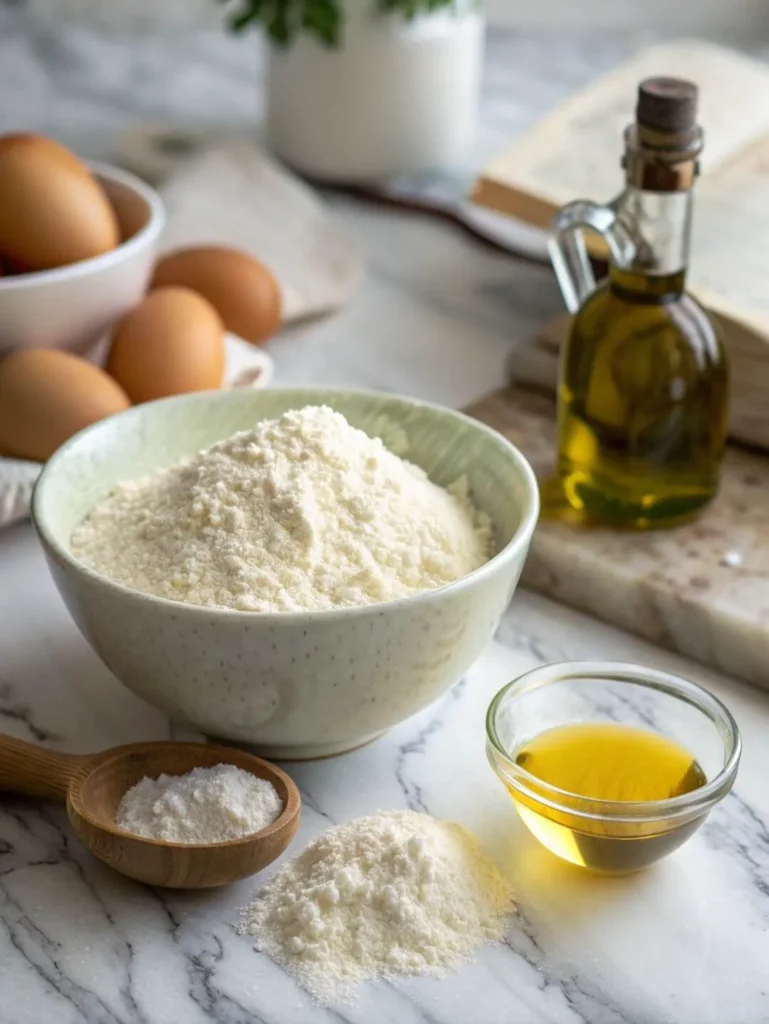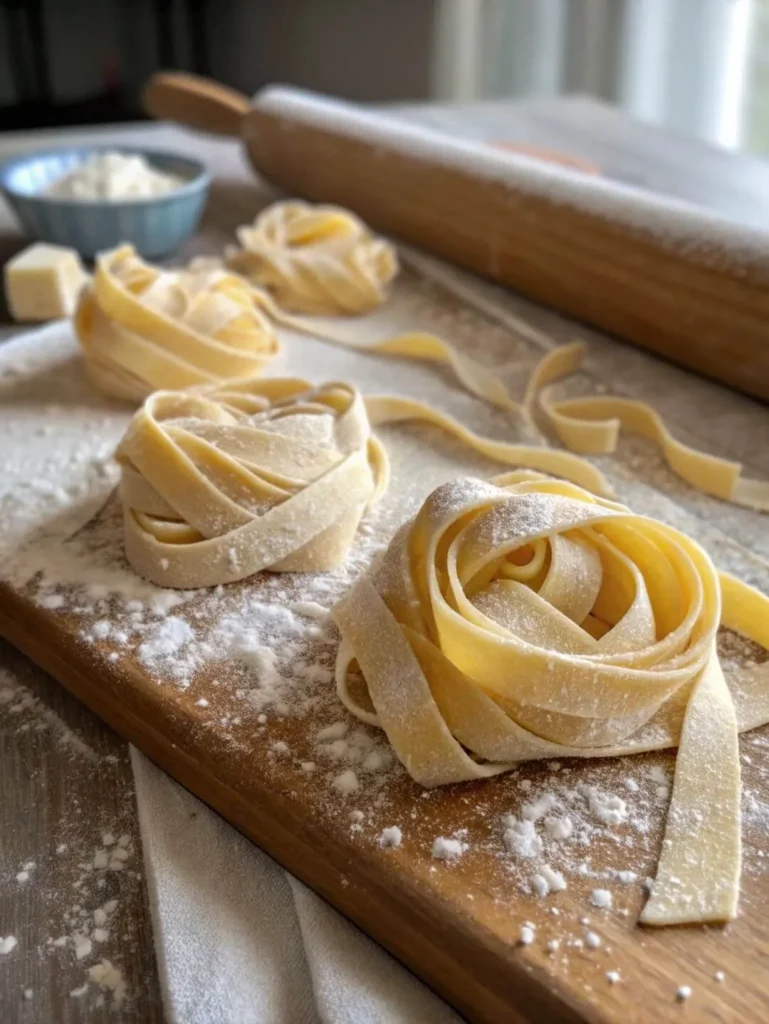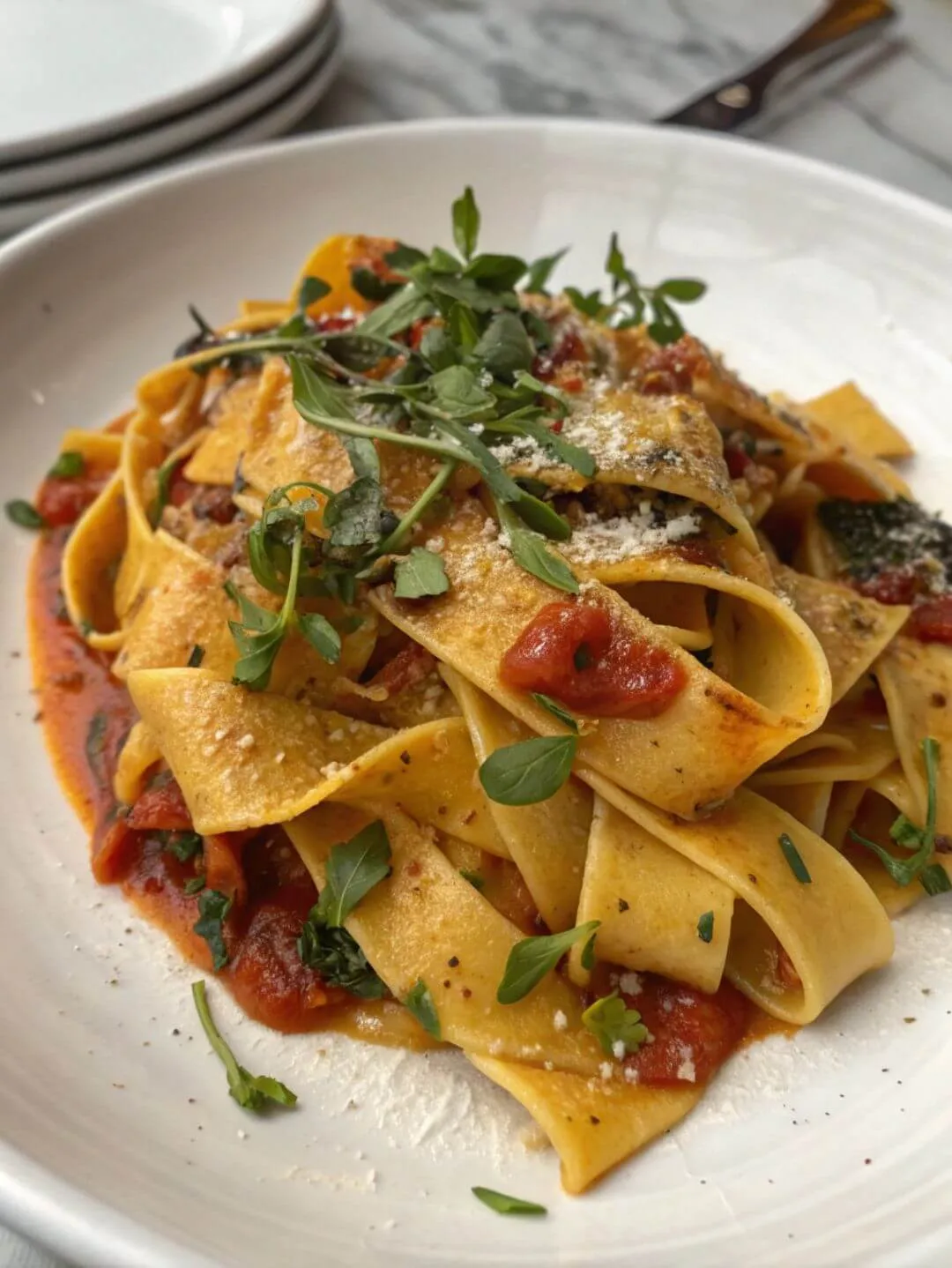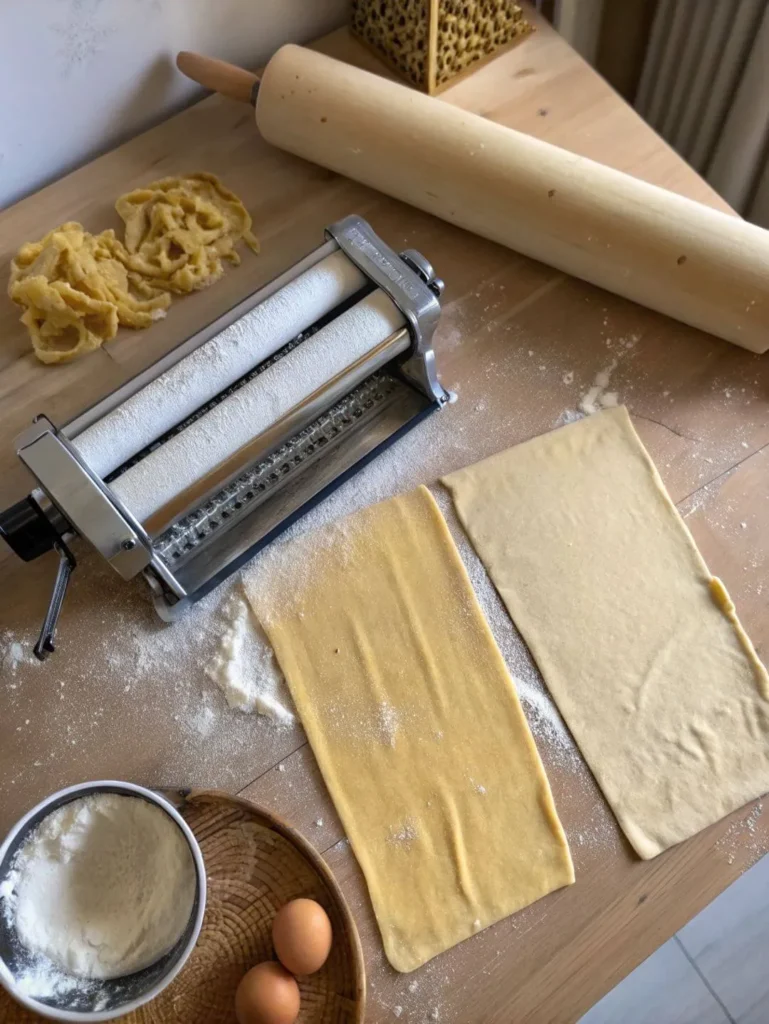Homemade pappardelle is more than just pasta, it’s a warm hug from the past, a reminder that food connects us to the people and places we love. I still remember making it for the first time in my grandmother’s kitchen, where I learned that good cooking isn’t about flawless technique—it’s about heart, hands, and a little joyful mess.
Even after decades of cooking across the globe, pappardelle remains one of my favorite go-to dishes. Its broad, silky ribbons soak up rich sauces beautifully, turning even a quiet weeknight meal into something memorable.
Whether you’re hand-rolling with a pin or running dough through a pasta machine, I’ll walk you through every step. Don’t stress about perfect cuts—those little imperfections? That’s what makes it feel homemade.
So, tie on your apron. It’s time to turn flour and eggs into something truly special.
What Is Pappardelle?
– Origins and Traditional Use
Homemade pappardelle is more than pasta—it’s tradition you can taste. Originating from Tuscany, this wide, flat ribbon noodle was designed for one purpose: soaking up the richest, heartiest sauces. The name itself comes from the Italian verb “pappare,” which means “to gobble up.” And trust me, that’s exactly what you’ll want to do.
In rustic kitchens across Italy, pappardelle has long been the star of Sunday dinners. Made fresh, often by hand, it pairs perfectly with bold, slow-cooked meat ragùs, creamy mushroom sauces, or even bright seasonal vegetables.
– What “pappare” Means in Italian
There’s something charming about how Italian names their pasta. “Pappare” captures the very essence of this noodle—it’s meant to be devoured with enthusiasm. The generous width (typically around 1 inch) makes it perfect for clinging to chunky sauces and capturing flavor in every fold.
In my kitchen, I reach for pappardelle when I want something that feels both rustic and elegant. It’s comforting but never boring, and it always tells a story on the plate.
What Flour to Use for Pappardelle?
– Traditional Italian Flour Choices
When it comes to making homemade pappardelle, the type of flour you choose can make all the difference. In traditional Italian kitchens, the gold standard is “00” flour—an ultra-fine, soft wheat flour that creates silky, smooth dough. It’s ideal for achieving that perfect bite that makes homemade pappardelle so satisfying.
If you don’t have “00” flour on hand, don’t worry. A mix of “00” and all-purpose flour works beautifully. This combo gives the pasta just enough strength while still being soft and tender. It’s an easy starting point if you’re new to making homemade pappardelle from scratch.
– Alternative Flours and Why They Matter
Want to experiment? Try incorporating whole wheat flour for a nuttier flavor and a heartier feel. Or add a bit of semolina flour to give your dough more structure and a subtle golden hue. You can even try small amounts of rye or spelt flour if you’re feeling adventurous.
For the best results, keep your blend around 75% white flour and 25% alternative flour. This keeps the dough easy to work with while adding unique texture and flavor to your homemade pappardelle.
Different flours also bring nutritional benefits. Whole grains increase fiber, while semolina is packed with protein and iron—making your pasta not just delicious, but more nourishing too.
Want to explore more flour types and pasta bases?
Learn more about noodle flour types and varieties
How to Make Homemade Pappardelle
– Ingredients You’ll Need

You don’t need a long list to make fresh pappardelle. In fact, part of its charm is how simple and classic it is. Here’s what you’ll need for a basic batch:
- 2 cups “00” flour (or a mix of 1½ cups “00” + ½ cup all-purpose)
- 3 large eggs
- 1 tablespoon olive oil
- 1/2 teaspoon salt (optional)
- 1 tablespoon water, as needed for texture
That’s it. No machines required—just your hands, a surface to work on, and a rolling pin if you’re going old-school.
– Step-by-Step Pasta Dough Instructions

1. Make a flour well
Pour your flour onto a clean countertop and use your hands or a fork to form a crater in the middle.
2. Add eggs and olive oil
Crack the eggs directly into the center of the flour. Add the olive oil and salt (if using).
3. Mix gently
Using a fork, slowly pull the flour into the eggs. Be patient—it will start to form a sticky dough.
4. Knead the dough
Once it comes together, use your hands to knead the dough for about 8–10 minutes. It should feel smooth and elastic but not sticky.
5. Rest the dough
Wrap the dough in plastic wrap or a clean towel and let it rest at room temperature for 30 minutes. This step relaxes the gluten and makes rolling easier.
6. Roll it out
Divide your dough in half and roll one piece at a time into a thin sheet. Whether by hand or machine, aim for a thickness of 1–2 mm.
7. Cut into ribbons
Using a sharp knife or pasta cutter, slice the dough into 1-inch wide strips. Congrats—you’ve got fresh pappardelle!
Nutrition Facts (Per Serving)
(Based on a standard homemade pappardelle recipe using eggs, “00” flour, and olive oil. One serving = ~100g fresh pasta)
| Nutrient | Amount |
|---|---|
| Calories | 280 kcal |
| Total Fat | 5 g |
| Saturated Fat | 1.5 g |
| Unsaturated Fat | 3.5 g |
| Trans Fat | 0 g |
| Cholesterol | 110 mg |
| Sodium | 20 mg |
| Total Carbohydrates | 45 g |
| Dietary Fiber | 2 g |
| Sugars | 1 g |
| Protein | 10 g |
Nutrition values are estimated and may vary based on ingredients and portion sizes.

Homemade Pappardelle
Equipment
- clean work surface
- fork
- mixing bowl (optional)
- rolling pin or pasta machine
- sharp knife or pasta cutter
- pot for boiling pasta
- colander
Ingredients
- 1 cup Italian “00” flour (or all-purpose)
- 1/2 cup semolina flour (optional for texture)
- 2 large eggs
- 1 tsp olive oil
- 1/4 tsp salt
- 1 tbsp water (if needed)
Instructions
- On a clean surface, create a mound of flour with a well in the center.
- Crack eggs into the well, add salt and olive oil. Use a fork to whisk the eggs, slowly incorporating the flour.
- Knead the dough with your hands for about 10 minutes until it becomes smooth and elastic. Wrap in plastic wrap and let rest at room temperature for 30 minutes.
- Divide the dough into two portions. Using a rolling pin or pasta machine, roll out the dough into thin sheets (about 1–2mm thick).
- Dust dough sheets with flour and fold gently. Slice into wide ribbons (about 1 inch wide). Unfold and dust with flour to prevent sticking.
- Boil in salted water for 2–3 minutes until tender. Drain and toss with your favorite sauce.
- Top with fresh herbs, grated Parmesan, or wild mushroom ragù.
Notes
Nutrition
Hand-Rolling vs. Pasta Machine: Which to Use?
– Rolling Pappardelle by Hand

If you’re making homemade pappardelle for the first time, hand-rolling might feel a little intimidating—but it’s surprisingly meditative. All you need is a rolling pin, a little patience, and a clean surface.
Start by flattening the dough with even pressure, rotating it frequently. You’re aiming for a thin, flexible sheet—around 1 to 2 millimeters thick. It should be thin enough to see your hand through it, but not so thin it tears.
Once you’ve rolled it out, lightly flour the surface, fold it gently like an accordion, and slice it into 1-inch wide ribbons. Unfurl the strips and toss them with flour to prevent sticking.
And here’s the beauty of it: those slightly uneven edges? They give your pasta soul. That rustic charm is what makes hand-cut pappardelle so special.
– Using a Pasta Machine
If you want speed and precision, a pasta machine is your best friend. I love using the Atlas 150 or a KitchenAid pasta roller attachment—they make the process faster without compromising texture.
Feed your rested dough through the widest setting first, then gradually work your way down to setting #5 or #6 for the perfect pappardelle thickness. You’ll get uniform sheets every time, which makes cutting the ribbons easier.
Once your sheet is ready, slice it into strips and dust with flour. Then, curl them into loose nests and let them rest or dry slightly before cooking.
– How to Freeze Pappardelle
Whether you’re hand-rolling or using a machine, don’t let leftovers go to waste—homemade pappardelle freezes beautifully.
Here’s how to do it:
- Lightly flour the noodles to prevent sticking.
- Curl them into small nests.
- Place the nests on a parchment-lined baking sheet and freeze until firm.
- Transfer to a freezer-safe bag or container.
They’ll keep for up to 2 months, and you can cook them straight from frozen—just add 1–2 extra minutes to your boil time.
What’s the Difference Between Pappardelle and Tagliatelle?
– Texture, Thickness, and Width
If you’ve ever stood in your kitchen trying to choose between homemade pappardelle and tagliatelle, you’re not alone. At first glance, they might seem similar—both are long, flat ribbons made from egg pasta dough—but they serve very different purposes on your plate.
Homemade pappardelle is typically cut about 1 inch wide, making it one of the broadest ribbon pastas. That width gives it a more substantial bite and the perfect surface to carry thick, chunky sauces. When I want a pasta that feels hearty and rustic, pappardelle is always my top pick.
Tagliatelle, by comparison, is narrower—about ¼ inch wide—and feels lighter and more refined. It’s great with creamy sauces or quick vegetable sautés, but it doesn’t hold up as well to heavier ingredients the way homemade pappardelle does.
– Cooking Applications
So, when should you choose one over the other? Let your sauce decide.
- If you’re working with a rich beef ragù, a slow-braised mushroom sauce, or anything with depth and texture, homemade pappardelle is your best friend. It grabs onto sauce, folds it into every bite, and delivers a mouthful of flavor.
- For lighter dishes—like a lemon-parmesan cream or delicate pesto—tagliatelle’s thinner width keeps the balance just right.
Both pastas are versatile, both delicious. But if your goal is to create a bowl of comfort that satisfies with every forkful, homemade pappardelle is the clear winner. It’s bold, rustic, and ideal for when you want your pasta to be the main event—not just a backdrop.
And if you’re making your pasta from scratch, the wider ribbons of homemade pappardelle are also easier to roll and cut, especially for beginners.
Variations and Toppings
– Classic Pairings
Homemade pappardelle shines with rich, comforting sauces. Try it with:
- Wild mushroom ragù – Earthy and savory, perfect for fall.
- Lemon cream & Parmesan – Light, fresh, and great for spring.
- Slow-cooked meat sauces – Like pork or beef ragù; the wide noodles hold onto every bit.
These pairings bring out the texture and sauce-hugging nature of the pasta beautifully.
– Seasonal Toppings
Switch things up with fresh, seasonal ingredients:
- Spring: Peas, asparagus, lemon zest
- Summer: Cherry tomatoes, basil, grilled zucchini
- Fall: Roasted squash, sage, browned butter
- Winter: Kale, caramelized onion, gorgonzola cream
Homemade pappardelle is a flexible base—it plays well with both rustic and refined flavors.
Craving something quick?
Try this Easy Spaghetti Recipe
FAQs About Pappardelle
What flour to use for pappardelle?
Traditional Italian recipes for homemade pappardelle use “00” flour, a finely milled soft wheat that gives the dough a silky texture. You can also use all-purpose flour, or a blend of both. For a rustic feel, try adding a bit of semolina or whole wheat flour.
What’s the difference between pappardelle and egg noodles?
Though both are egg-based, pappardelle is much wider and thicker than typical egg noodles. It’s cut into broad ribbons (about 1 inch wide) and is better suited for hearty, chunky sauces, while egg noodles are thinner and more delicate.
What makes pappardelle unique from other pasta?
Its width and structure. The broad shape allows it to soak up thick sauces and deliver bold flavor in every bite. Homemade pappardelle is especially good at clinging to meat-based ragùs and creamy mushroom blends.
What is the closest pasta to pappardelle?
Tagliatelle is the closest match—it’s made with the same egg dough but is narrower (about ¼ inch wide). Fettuccine is another close cousin, though it’s even thinner. All three can be substituted, but only pappardelle gives that bold, rustic feel.
Conclusion: Why Pappardelle Deserves a Spot in Your Pantry
Homemade pappardelle isn’t just a meal, it’s a ritual. From the gentle rhythm of kneading dough to that first silky bite drenched in sauce, it transforms an ordinary dinner into something soulful and satisfying.
Whether you pair it with a rich raga or fresh seasonal produce, its wide, tender ribbons are built to carry flavor and comfort. It’s a forgiving, rustic pasta that welcomes both creativity and tradition, perfect for novice cooks and seasoned pros alike.
Making pappardelle from scratch brings a kind of joy that no packaged pasta can offer. It’s personal. It’s hands-on. And it’s a delicious reminder that the best food often starts with a simple mix of flour, eggs, and intention.
So the next time you crave something warm, homemade, and meaningful, skip the box. Reach for your rolling pin and make something timeless: pappardelle, from your own hands.
Want more classic Italian comfort?
Discover creamy goodness in our Fettuccine Alfredo Recipe
Explore essential noodle types and varieties
Looking for something faster? Try our Easy Spaghetti Recipe

6 thoughts on “Homemade Pappardelle”